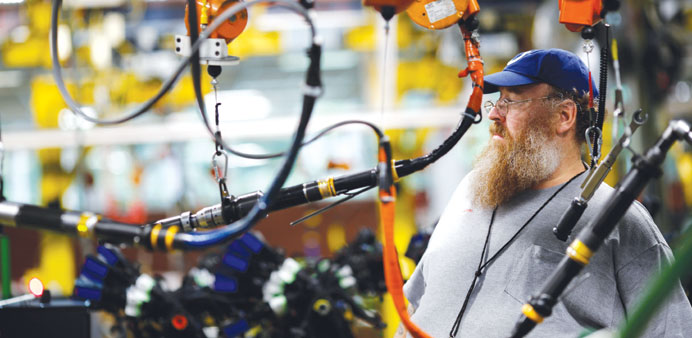An employee works at the Cummins diesel engine plant in Columbus, Indiana. US manufacturing has been hurt by a strong dollar and slower demand in Europe and Asia.
Reuters/Washington
US private employers added the smallest number of workers in more than a year in March and factory activity hit a near two-year low, fresh signs that economic growth slowed significantly in the first quarter.
Activity braked in the first quarter, held back by bad weather, a strong dollar, weaker overseas demand and a now-settled labor dispute at the country’s busy West Coast ports.
“The US economic recovery is continuing to leak momentum. Growth is expected to slow to a crawl in the first quarter,” said Millan Mulraine, deputy chief economist at TD Securities in New York.
The ADP National Employment Report yesterday showed that private payrolls increased by 189,000 jobs last month, the smallest gain since January 2014.
That was well below economists’ expectations for an increase of 225,000. Manufacturing payrolls declined for the first time since January of last year.
The ADP report, which is jointly developed with Moody’s Analytics, was released ahead of the government’s more comprehensive employment report tomorrow.
“There are some good reasons to think that the job growth has slowed, that we’re not going to see monthly job gains of 300,000 for a while,” said Mark Zandi, chief economist of Moody’s Analytics.
While the ADP report is not a very good predictor of nonfarm payrolls, it signals softness in job growth. Employers likely added 245,000 to their payrolls last month after hiring 295,000 workers in February, according to a Reuters survey of economists.
In a separate report, the Institute for Supply Management (ISM) said its national factory activity index fell to 51.5 last month, the lowest reading since May 2013, from 52.9 in February.
A reading above 50 indicates expansion in the manufacturing sector. It was the 28th consecutive headline reading at or above 50. The new orders index eased to 51.8 last month from 52.5 in February, and the employment index fell to 50 from 51.4, both also at 22-month lows.
US stocks fell, while prices for US government debt rose after the data. The dollar was lower against the euro and yen.
Manufacturing has been hurt by a strong dollar and slower demand in Europe and Asia. The dollar has gained 12% against the currencies of the main US trading partners since June of last year.
Multinational Corps such as technology giant IBM, semiconductor maker Intel Corp, industrial conglomerate Honeywell and Procter & Gamble, the world’s largest household products maker, have warned that the dollar will hurt their profits this year.
In addition, lower crude prices have squeezed profits for oil companies, prompting some to either postpone or scrap capital expenditure programmes.
The sector, which accounts for about 12% of the economy, continues to deal with supply chain disruptions created by the now-resolved labour dispute at the West Coast ports.
Separately yesterday, the Commerce Department said construction spending dipped 0.1% to an annual rate of $967.2bn. January’s outlays were revised to show a 1.7% decline instead of the previously reported 1.1% drop.
That could see economists further mark down their first-quarter growth forecasts. Estimates for first-quarter gross domestic product range between a 0.8% and 1.2% annual pace. The economy expanded at a 2.2% rate in the fourth quarter.
Construction spending in February was restrained by a 0.8% drop in public construction outlays.
Spending on federal government projects jumped 9%, but that was offset by a 1.6% plunge in state and local government outlays — the largest portion of the public sector segment.



